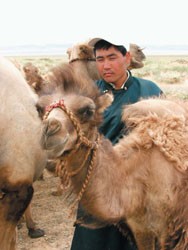
This article describes some of the activities of USAID's Gobi Regional Growth Initiative. This project, along with its successor Gobi Regional Growth Initiative II, was implemented by Mercy Corps 1999-2008.
Throughout the Gobi and much of Mongolia, the Bactrian camel has become a symbol of Mongolia, for tourists and locals alike. Almost two-thirds of Mongolia’s camels are in the Gobi region. The camel is perfect for the conditions and the lifestyle of the nomads, where temperatures range from 40 degrees Celsius in the summer to -40 degrees Celsius in the harsh winters. Camels can travel long-distances, carry heavy loads, and survive up to two weeks without water and a couple of months without food.
Ikhbayar and his family are a typical Mongolian camel herder family. Like half of Mongolia’s population, they are nomadic and move their ger - a traditional Mongolian tent - with their animals several times a year in search of better grazing pastures and water. However, the number of camels in Mongolia has declined dramatically in the past several decades. There are about 255,000 camels left in Mongolia - just fifty years ago there were an estimated 894,000.
Over the past decade, the population in the Gobi has also been steadily declining as herders have moved to urban areas in search of economic opportunities. USAID is helping to develop and strengthen rural businesses and improve the livelihoods of Gobi herdsmen like Ikhbayar. Ikhbayar and his family are learning to increase their income and sustain their livelihood through the development of herder cooperatives, training programs, and market-development activities.
The USAID program is helping traditional camel herders diversify their businesses, expand their product lines, and link them to new market opportunities - while maintaining the camel population. The goal is to increase the number of new Gobi businesses as well as strengthen existing productive businesses by increasing the availability, access to, and use of business information by Gobi entrepreneurs.
Herder groups and cooperatives are being helped to identify and secure sources of raw materials, equipment, and financing. Camels provide valuable milk and wool which is used for everything from clothing to rope, as well as meat and dung for fires and cooking. The USAID-funded training has enabled Ikhbayar to increase the family income through better marketing of their products, building market linkages, and understanding the true value of their agricultural products.
Through the program’s activities and promotion of agricultural market fairs, Ikhbayar and his family are marketing their dairy products in the main provincial town. Ikhbayar’s wife Tseveljamts is busy making curds from camel milk, and this year she is trying something new - after receiving training, she has started to experiment in making different flavors and shapes of the camel milk curds. The family hopes to have a good market for the improved and varied curd products.







Comment
Make a general inquiry or suggest an improvement.